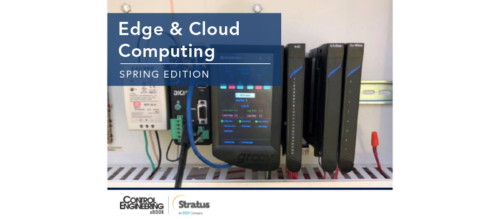High-tech Cart Control System
New automated guided carts at a major carbonated-beverage producer cost half of typical automated guided vehicles and yield major benefits.
www.controleng.com/archive https://weareaim.com/Public/Welcome.aspx www.beckhoffautomation.com/usa/default.htm
Unique, new automatic guided carts (AGCs) with advanced-automation features are having a major impact at a new distribution center built by a major carbonated-beverages producer in the southeastern part of the U.S. The AGCs consist of a standard burden-carrier base with an adaptable top to which different load-handling devices, such as roller decks or lifting forks, can be added. They have onboard battery systems that can power the cart for up to eight hours and, with opportunity charging, can fully recharge in as little as five minutes. The AGC system also features RFID technology onboard. However, the newest significant concept is its control system.
“The new AGCs are easier for end users to integrate and cost about half as much as traditional automated guided vehicles, making the technology attainable for far more applications than previously possible,” says Tommy Hessler, CEO of America in Motion (AIM), maker of the carts.
New automated guided carts are easier to integrate and cost less, AIM says.
“It’s quite easy to add or remove capacity based on the type of load the AGC must handle, due to the modular structure of the Beckhoff controls.”
Controls from Beckhoff Automation LLC have allowed AIM to integrate intelligence into the vehicle, notes Theresa Blasius, vp of engineering at AIM. “Our AGCs can be best utilized in applications that already have some automation control, such as robot cells or automatic conveyor systems with a PLC. Via OPC (open connectivity via open standards), these types of controllers can easily command our AGC to carry the load anywhere in the facility,” she says.
For the beverage producer, Derek Clever, project manager, says, “We looked into some other manufacturers, but we selected the AIM AGCs because AIM listened to our requirements and designed a system around them, instead of trying to sell standard products and workarounds that met our needs halfway. AIM also helped us develop true solutions, not just simple products. The AIM system has the capability to produce orders in real time, identifying each case on every pallet and generating advanced shipping notices that lead to order visibility throughout the entire distribution system. This ultimately improves customer service.
“The AIM system improves quality, reliability, and efficiency by automating the repetitive and labor-intensive order-building process, which virtually eliminates human picking errors,” continues Clever. “Also, the system’s productivity can increase capacity as the business grows, with minimal additions to financial or human capital. The Beckhoff components were key components adding to the flexibility of the AIM system.”
Hessler says AIM “considered a non-PC-based approach, but decided against it, since we needed the ability to run our C# programs onboard, and we decided to make full use of the features that Microsoft Windows CE offers for our applications. This way, we can integrate voice-activated commands, which is much easier with the open
Beckhoff system than with our competitors’ closed alternatives.”
“No closed, proprietary controls are found in any of our AGCs,” Hessler adds. “We want our customers to have the ability to easily handle AGC maintenance if desired.” AIM uses the Beckhoff CP7202 panel PC with its 15-in. touchscreen as an all-in-one system controller and user interface.
Installed in a central location as a fixed AGC operator station, the CP7202 handles a broad range of functionality, including routing and traffic management, overall system logic for the AGCs and I/O data from stationary devices, such as the AGC battery chargers, load stands or other machinery. Other functions include traffic management, vehicle-selection optimization, vehicle-task management, load tracking, path-programming logic and AGC fault finding and diagnostics.
Onboard, the AGCs are equipped with CX1010 embedded PCs, which function as programmable-automation controllers. The CX1010 devices are directly connected to Beckhoff bus-terminal I/O modules and TwinSAFE terminals for streamlined implementation of safety devices on the AGCs. TwinSafe terminals do not require a dedicated safety PLC, which greatly reduces hard wiring of safety devices, can communicate over multiple, standard field buses and can be used alongside regular bus-terminal I/O with almost no restrictions. AIM also installed distributed Beckhoff I/O near the panel PC stations and utilizes wireless local area network (WLAN) communication between the panel PC and the CX1010 onboard the AGCs.
“The CX1010 with a 500 megahertz Intel Pentium MMX (single instruction set)-compatible processor is our standard AGC controller, but we sometimes use the one gigahertz CX1020, when more central-processing unit horsepower is required, such as for weighing and scanning of products,” Hessler says. “It’s quite helpful that the CX family of PCs can scale up in power whenever a processing boost is needed.”
The onboard CX1010 embedded PC handles all internal functions required for the AGC to operate, partly using TwinCAT PLC software from Beckhoff and partly through C# software developed by AIM.
The major functions are guidance (magnetic tape or wire), routing via RFID, charging, steering control, drive control and precision stop, manual control via pendant, automatic load handling and safety devices that are managed by TwinSafe.
www.controleng.com
Author Information
Jack Mans is plant operations editor for Packaging Digest magazine, www.packagingdigest.com , a Reed Business Information publication.
Do you have experience and expertise with the topics mentioned in this content? You should consider contributing to our CFE Media editorial team and getting the recognition you and your company deserve. Click here to start this process.





